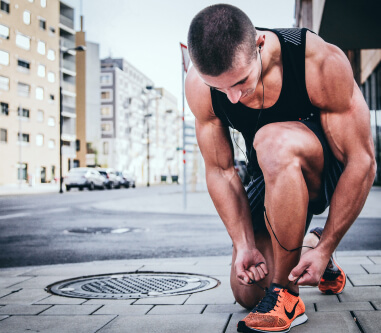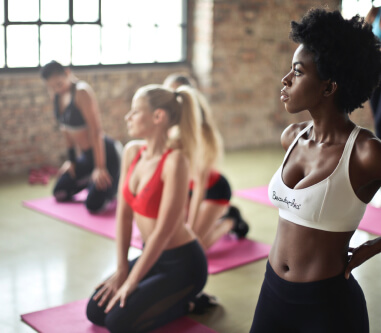Chair Yoga Exercises for Beginners and Seniors
Love yoga but are worried that lack of experience, balance or mobility issues may mean it’s not for you? SES yoga instructor Steph Green explains why chair yoga is a great way to reap the benefits of yoga, especially for older people and beginners.
What is chair yoga?
Chair yoga is a modified form of yoga that involves practicing asanas and pranayama (breathing exercises) while sitting or using a chair for support. It is designed to be accessible to people who have limited mobility or difficulty standing for long periods of time.
What are the benefits of chair yoga?
Chair yoga has the same physical and mental benefits as yoga, with the added advantage that it can be practiced by anyone who can’t stand for long periods of time. Chair yoga is a gentle practice suitable for beginners, older people and those with disabilities or mobility issues.
Some of the benefits of practicing chair yoga poses include:
Increased flexibility and reduced stiffness. Chair yoga helps to stretch muscles and increase flexibility, reduce joint stiffness and improve overall mobility.
Increased strength and stability. While yoga is often thought of as just stretching muscles, many poses help to build strength and stability by working against the resistance of gravity and body weight to keep the body balanced.
Better posture and body coordination. Chair yoga helps improve core strength and stretches the posterior chain, including the muscles in the back and shoulders. It also helps increase awareness of body coordination. Over time, this can help improve posture and reduce stress on the spine and hips.
Reduces stress and anxiety. Yoga practices include breathing and meditation, which can be effective in relieving stress and anxiety. Incorporating these elements into your daily life can also help reduce your reactivity to daily stress and build your mental resilience.
Boosts circulation. While chair yoga is unlikely to count as high-intensity aerobic exercise, the different poses help boost circulation, which is good for heart health.
Chair yoga can serve as a gateway into other types of yoga, but it can equally be practiced indefinitely as the sole form of yoga.
Why is chair yoga good for seniors?
Anyone can practice chair yoga, but one of the reasons it’s good for seniors is that it allows them to reap the benefits of yoga in a safe way.
As we age, we’re more likely to experience decreased balance, limited mobility, and reduced strength. Jumping headfirst into a more intense yoga practice without a good foundation in strength and balance can increase your risk of injury and falls.
Practicing yoga poses with the aid of a chair can reduce this risk and make yoga easier to practice, thereby building strength and stability. Some people may find that after practicing chair yoga for seniors, they can move on to other types of yoga, while others may prefer to continue practicing chair yoga.
Is chair yoga good for beginners?
All forms of yoga are suitable for beginners, but some styles are more challenging than others. Chair yoga can be easily modified to suit all experience levels, so it can help beginners build strength, stability, and flexibility to more easily practice standing poses.
11 Chair Yoga Exercises Worth Trying
All you need to start practicing chair yoga is a chair. You don't need to buy a specialized yoga chair, but ideally, your chair should not have wheels and your feet should be able to touch the floor when you sit down. If your feet can't touch the floor, you can place blocks or a folded yoga mat under your feet to give yourself a solid foundation.
You can do the following chair yoga poses in sequence, or you can choose a few to string together to form a flow that suits your available time and abilities.

Beginner Chair Yoga Flow
Chair Cat-Cow Stretch – Bitilasana Marjaryasana
Strength: Back, Core
Stretches: Neck, Shoulders, Back, Hips, Abdomen, Chest
Sit in a chair with your spine straight and your feet on the floor. Place your hands on your knees or upper thighs.
As you inhale, arch your spine and roll your shoulders down and back, bringing your shoulder blades to your back. This is Cow Pose.
As you exhale, bend your spine and lower your chin to your chest, bringing your shoulders and head forward. This is Cat Pose.
Continue moving in Cow Pose on the inhale and Cat Pose on the exhale for five breaths.
Chair Hands Up – Urdhva Hastasana
Strength: Triceps, Shoulders, Core
Stretches: Shoulders, Neck, Chest
As you inhale, lift your arms toward the ceiling.
Maintain good upper body posture with your shoulders relaxed and your chest naturally over your hips.
Anchor your sitting bones to the seat of the chair and stretch upward from there.
Chair Forward Bend – Uttanasana
Strengthens: Hip flexors, shoulders
Stretches: Back, hamstrings, neck
As you exhale, bend forward and try to keep your chest against your thighs. Place your hands on the floor, trying not to touch the floor. Let your head hang down.
As you inhale, raise your arms above your head. Repeat this movement between the raised arm pose and the forward bend several times, moving in time with your breath.
Chair Extended Side Angle Pose – Utthita Parsvakonasana
Strengthens: Back, shoulders, neck
Stretches: Chest, core, shoulders, hips
After the last forward bend, stay bent. Place the fingertips of your left hand on the floor outside your left foot. If your left hand doesn’t come to the floor easily, place a block under your hand or place it on your left knee and twist from there.
As you inhale, twist to the right, open your chest, lift your right arm, and look up at the ceiling. This is the Chair Extended Side Angle Pose. Hold this pose for several breaths. As you exhale, lower your right arm.
Do the same pose with your right arm lowered and your left arm raised.
Chair Pigeon – Eka Pada Rajakapotasana
Stretches: glutes, hip flexors, lower back
Sit back up. Place your right ankle on your left thigh, trying to keep your knee in line with your ankle. Hold Chair Pigeon for three to five breaths.
You can bend forward to intensify the stretch if you wish.
Repeat with your left leg.
Chair Eagle – Garudasana
Strengthens: Core, Legs
Stretches: Shoulders, Back, Legs
Cross your right thigh over your left thigh to get into Eagle Pose. If you can, wrap your right foot completely around your left calf.
Cross your left arm over your right elbow. Bend your elbow so your palms touch.
Lift your elbow while lowering your shoulders away from your ears. Hold for three to five breaths.
Repeat on the other side.
Chair Spine Twist – Ardha Matsyendrasana
Strengthens: Core
Stretches: Back, Core, Shoulders, Hips
Sit sideways on a chair, facing your left side. Twist your torso to the left, grabbing the back of the chair, into a spinal twist.
Lengthen your spine with each inhale, and twist with each exhale, for five breaths.
Move your legs to the right side of the chair and repeat the twist to the right.
Chair Warrior I - Virabhadrasana I
Strengths: Shoulders, Arms, Legs, Hips, Core
Stretches: Hips, Chest, Back
Now, keep your right leg in position at the side of the chair while swinging your left leg back.
Place the sole of your left foot on the floor, roughly parallel to the chair seat, and straighten your left leg so that you are standing but supported by the chair.
Inhale and lift your arms to the ceiling, coming into Warrior 1, keeping your torso toward your right leg. Hold for three breaths.
Chair Warrior II - Virabhadrasana II
Strengths: Legs, Hips, Shoulders, Core
Stretches: Hips, Shoulders, Chest
On an exhale, open your arms, right arm forward and left arm back.
Pull your left hip back and rotate your torso to the left, aligning it with the front of the chair.
Gaze at the fingertips of your right hand and hold Warrior II for three breaths.
Chair Reverse Warrior - Viparita Virabhadrasana
Strengthens: Shoulders, Arms, Legs, Hips, Core
Stretches: Hips, Chest, Back, Sides
Let your left arm drop down your left leg and raise your right arm toward the ceiling as you inhale into Reverse Warrior. Hold for three breaths.
Bring your legs to the front of the chair and sit sideways in the chair, facing your left side, for a series of three Warrior poses on your left side.
Final Relaxation: Chair Savasana
At the end of your practice, take a few minutes to sit with your eyes closed and your hands on your knees. Seated Savasana will help your body absorb all the good effects of the poses you've performed and help you get through the rest of the day.
Remember to maintain a comfortable and steady pace when performing these exercises and always listen to your body. If you experience discomfort or pain, adjust the movements accordingly. When beginning a new exercise program such as Chair Yoga, we recommend consulting a healthcare professional first, especially if you have any pre-existing health conditions.







